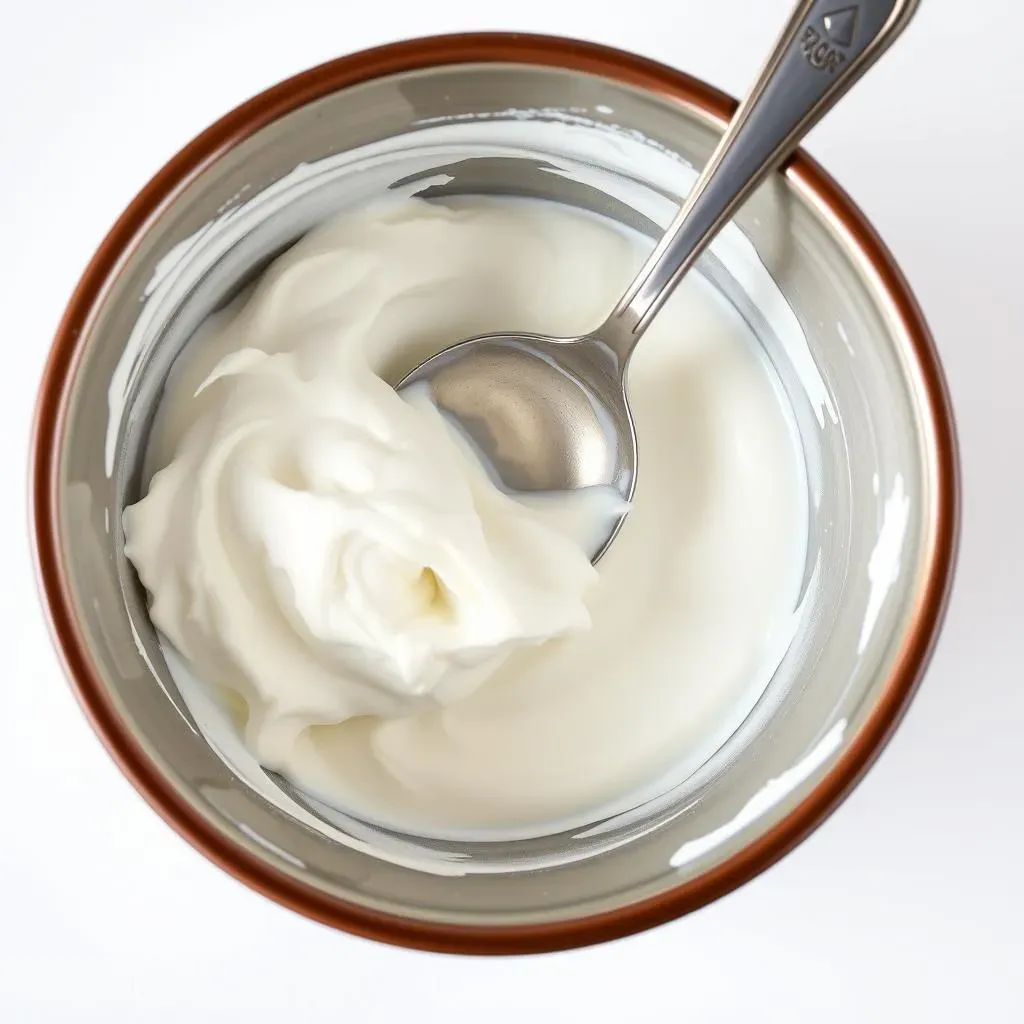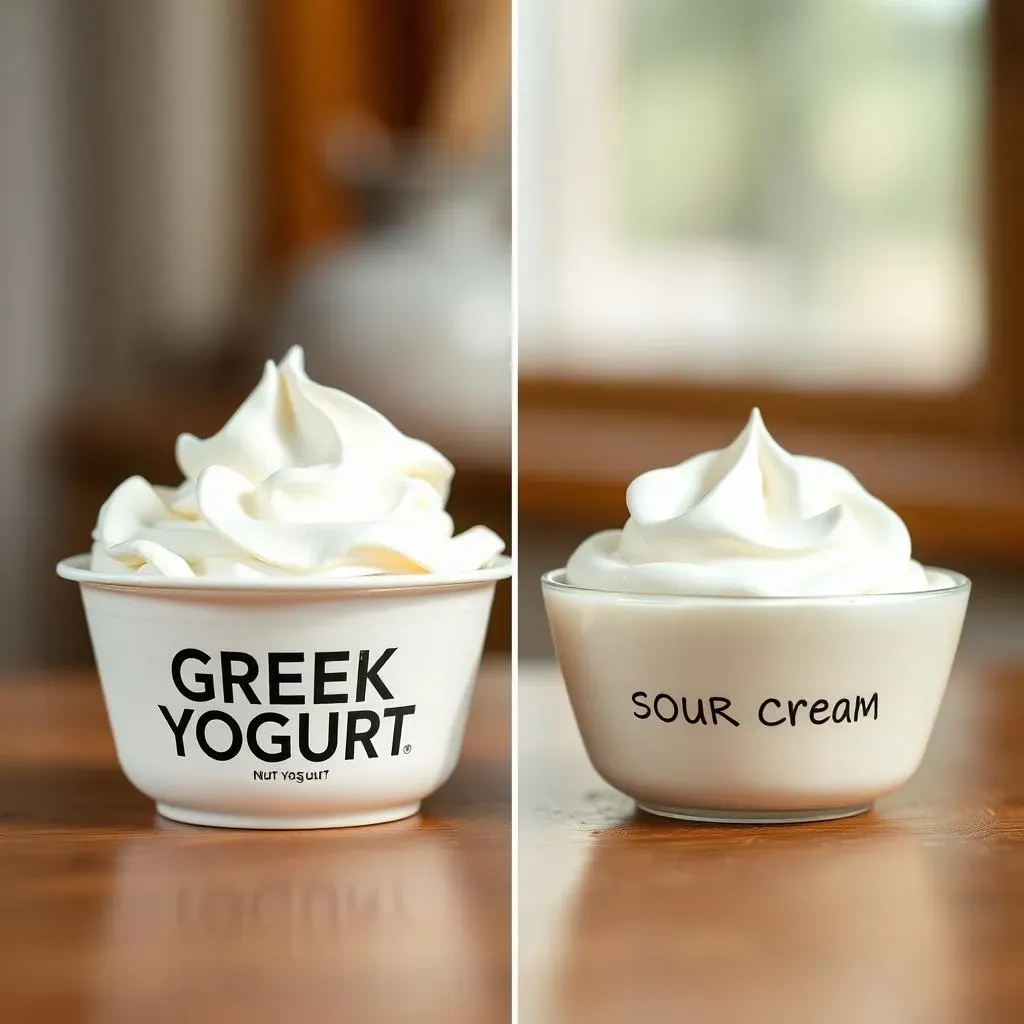Table of Contents
Have you ever stared blankly at a recipe, realizing you're missing a key ingredient – sour cream? Don't panic! This article tackles the burning question: can I substitute Greek yogurt for sour cream? We'll explore the nuances of this common kitchen swap, providing you with the knowledge to confidently navigate your next culinary adventure. We'll dive into the specifics of using Greek yogurt as a substitute, comparing its performance in both sweet and savory applications. Discover how the texture and taste differences might impact your baking and cooking, and learn helpful tips and tricks to achieve the best results. Whether you're aiming for a healthier option or simply need a quick replacement, this comprehensive guide will equip you with the information you need to make informed decisions. We’ll also compare the nutritional profiles of Greek yogurt and sour cream, helping you understand the impact of this substitution on your diet. So, let's get started and unravel the mysteries surrounding this versatile ingredient swap! Get ready to master the art of substituting Greek yogurt for sour cream and unlock a world of culinary possibilities.
Can I Substitute Greek Yogurt for Sour Cream in Baking?

Can I Substitute Greek Yogurt for Sour Cream in Baking?
The Great Yogurt Swap: Baking Edition
So, you're wondering if you can swap Greek yogurt for sour cream in your baking? The short answer is: often, yes! But it's not a *perfect* one-to-one replacement. Think of it like this: sour cream and Greek yogurt are cousins, not twins. They share some family resemblances (creamy texture, slight tang), but they have distinct personalities. Sour cream tends to be richer and tangier, while Greek yogurt can be a bit more… well, yogurty. The fat content plays a big role; full-fat Greek yogurt gets you closer to sour cream's richness than its low-fat cousin. For recipes where sour cream contributes mainly moisture and a touch of tang, like muffins or quick breads, Greek yogurt is a fantastic stand-in. However, if the sour cream is a star player in the flavor profile, like in certain cheesecakes, you might need to adjust the recipe to compensate for the flavor difference.
For instance, you could add a squeeze of lemon juice to your Greek yogurt to boost the tang, mimicking sour cream's sharper edge. Remember that Greek yogurt is thicker, so you might need to adjust the amount of liquid in your recipe. Too much yogurt might make your baked goods dense. If you're baking something delicate, like a cake, it's always best to do a small test batch first to see how the swap affects the final product. You can always check out our guide on substituting Greek yogurt in baking for more detailed tips.
Ingredient | Sour Cream | Greek Yogurt |
|---|---|---|
Fat Content | Higher | Variable (check the label!) |
Texture | Smooth, creamy | Thicker, sometimes slightly grainy |
Taste | Tangy, slightly salty | Tangy, but can be more "yogurty" |
Let's say you're making pancakes. Sour cream adds a lovely fluffy texture and subtle tang. Swapping in Greek yogurt will still create tasty pancakes, but they might be slightly denser and less tangy. To combat this, you could add a pinch of salt and a dash of lemon juice to the batter. This little tweak will bring you closer to that sour cream magic. On the other hand, in a recipe like muffins, where the sour cream is mainly a moistening agent, the substitution is usually seamless. The key is to understand the role of the sour cream in the recipe.
One thing to keep in mind is that the type of Greek yogurt matters. Full-fat Greek yogurt will give you the closest approximation to sour cream's richness. Low-fat or non-fat Greek yogurt can be a bit thinner and less flavorful, potentially impacting the final texture and taste of your baked goods. If you want to learn more about other substitutes, you might find our article on substituting buttermilk for sour cream in baking helpful!
- Always check the fat content of your Greek yogurt.
- Adjust the amount of liquid in your recipe if necessary.
- Consider adding lemon juice or vinegar to enhance the tang.
- Don't be afraid to experiment!
Using Greek Yogurt as a Sour Cream Substitute in Savory Dishes

Using Greek Yogurt as a Sour Cream Substitute in Savory Dishes
Savory Swaps: Greek Yogurt Takes Center Stage
Now, let's talk savory! Greek yogurt shines in many savory dishes, often acting as a secret weapon for creaminess and tang. Think creamy dips, zesty sauces, and flavorful toppings. It's a fantastic substitute for sour cream in dishes where the sour cream's role is primarily to add richness and a bit of acidity. In dishes like chili, tacos, or even as a topping for baked potatoes, Greek yogurt can easily step in. The tangy flavor complements many savory profiles beautifully. However, remember that Greek yogurt's texture is a bit thicker than sour cream, so you might need to thin it out with a little milk or water if the recipe calls for a pourable consistency. For more detailed information on using Greek yogurt in different recipes, check out our guide on using Greek yogurt in recipes.
Let's take a classic example: a creamy tomato soup. Sour cream adds richness and a touch of tang. Swapping in Greek yogurt will provide similar results, creating a creamy, slightly tangy soup without overpowering the tomato flavor. The thickness of the Greek yogurt will also help to create a satisfying texture. However, if you're aiming for a super smooth soup, you might want to whisk the yogurt in slowly to prevent it from clumping. A simple trick is to blend a small amount of the soup with the yogurt before adding the rest, ensuring a smooth consistency. You can also find more details on substituting Greek yogurt for sour cream here!
- Start by using a 1:1 ratio of Greek yogurt to sour cream.
- Thin the yogurt with milk or water if needed for a pourable consistency.
- Whisk the yogurt in slowly to prevent clumping.
- Taste and adjust seasoning as needed.
For example, imagine you're making a creamy spinach and artichoke dip. Sour cream is traditionally used to create a luxurious, creamy base. Substituting Greek yogurt can deliver surprisingly similar results, providing a tangy and creamy dip that's both delicious and potentially healthier. The slight graininess of some Greek yogurts might not be noticeable in a dip with a chunky texture. However, if you prefer a smoother dip, you can always strain the yogurt through cheesecloth to remove excess liquid. This simple step will create a smoother, creamier base for your dip. If you're looking for more ideas, you can learn more about using Greek Yogurt in recipes.
Remember, the key to success with savory substitutions is understanding the role of the sour cream in the recipe. If it's primarily contributing richness and creaminess, Greek yogurt is a great option. If the sour cream is a crucial element of the flavor profile, you might need to make minor adjustments to the recipe, adding a pinch of salt, a squeeze of lemon juice, or a touch of another acidic ingredient to achieve the desired balance. For more information about other alternatives, check out our guide on substituting cream cheese for sour cream.
Dish | Sour Cream Role | Greek Yogurt Adaptation |
|---|---|---|
Chili | Creaminess, slight tang | Direct swap; may thin with broth if needed |
Taco Topping | Creaminess, tang | Direct swap; works well! |
Dips (Spinach Artichoke, etc.) | Creamy base | Direct swap; strain for extra smoothness |
Greek Yogurt vs. Sour Cream: Texture, Taste, and Nutritional Differences

Greek Yogurt vs. Sour Cream: Texture, Taste, and Nutritional Differences
Greek Yogurt vs. Sour Cream: A Head-to-Head
Let's get down to the nitty-gritty: how do Greek yogurt and sour cream actually differ? Understanding these differences is key to making smart substitutions. First off, texture: sour cream is famously smooth and creamy, like a luxurious cloud. Greek yogurt, on the other hand, tends to be thicker and can sometimes have a slightly grainy texture, depending on the brand. This difference in texture is largely due to the production process; Greek yogurt is strained to remove whey, resulting in a denser product. If you're aiming for a super-smooth result, straining your Greek yogurt through cheesecloth can work wonders, giving you a texture closer to sour cream.
Next up, taste: both have a tangy profile, but they're not identical twins. Sour cream typically boasts a sharper, more pronounced tang, while Greek yogurt's tang is often milder and more subtly yogurty. This difference in taste is partly due to the bacterial cultures used during production. To enhance the tang of Greek yogurt to better match sour cream, a dash of lemon juice or white vinegar can be a game-changer. A tiny pinch of salt can also help to mimic sour cream's slightly salty undertone. For more information on achieving the perfect tang, check out our article on making Greek yogurt taste like sour cream.
- Sour cream: Smooth, creamy texture; sharp tang.
- Greek yogurt: Thicker, sometimes grainy; milder tang.
- Strain Greek yogurt for a smoother consistency.
- Add lemon juice or vinegar to boost tang.
Finally, let's talk nutrition. Both are dairy products, but their nutritional profiles differ. Greek yogurt generally packs a higher protein punch than sour cream, making it a more protein-rich swap. However, sour cream often contains a higher fat content, which can contribute to richness and creaminess in your recipes. The fat content can vary significantly between brands and types of Greek yogurt, so always check the nutrition label to compare. Ultimately, the "better" choice depends on your individual dietary needs and preferences. If you're interested in other dairy alternatives, you might want to check out our article on substituting crème fraîche for sour cream.
Here's a quick nutritional comparison table (values are approximate and may vary depending on the brand):
Nutrient | Sour Cream (per 100g) | Greek Yogurt (per 100g) |
|---|---|---|
Calories | ~200-250 | ~60-100 |
Fat | ~15-20g | ~0-10g (varies greatly) |
Protein | ~2-3g | ~10-15g |
Remember, these are just general guidelines. Always check the specific nutritional information on the packaging of your chosen brands of sour cream and Greek yogurt for the most accurate comparison.